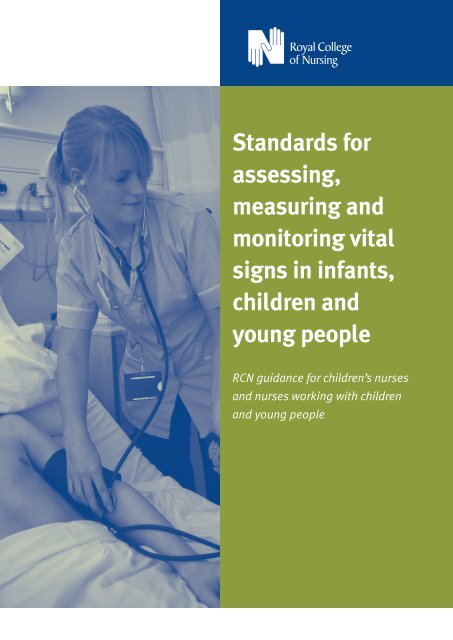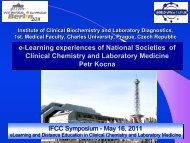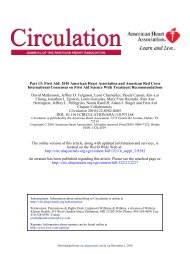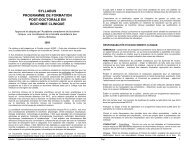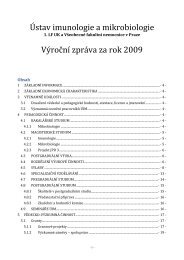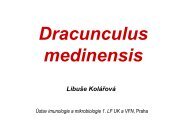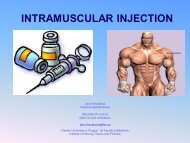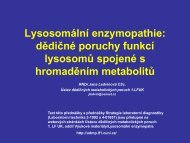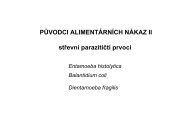Standards for assessing, measuring and monitoring vital signs in ...
Standards for assessing, measuring and monitoring vital signs in ...
Standards for assessing, measuring and monitoring vital signs in ...
- No tags were found...
Create successful ePaper yourself
Turn your PDF publications into a flip-book with our unique Google optimized e-Paper software.
<strong>St<strong>and</strong>ards</strong> <strong>for</strong><br />
<strong>assess<strong>in</strong>g</strong>,<br />
<strong>measur<strong>in</strong>g</strong> <strong>and</strong><br />
<strong>monitor<strong>in</strong>g</strong> <strong>vital</strong><br />
<strong>signs</strong> <strong>in</strong> <strong>in</strong>fants,<br />
children <strong>and</strong><br />
young people<br />
RCN guidance <strong>for</strong> children’s nurses<br />
<strong>and</strong> nurses work<strong>in</strong>g with children<br />
<strong>and</strong> young people
Acknowledgements<br />
We would like to thank everyone who gave their<br />
expertise <strong>and</strong> guidance to develop these st<strong>and</strong>ards.<br />
Expert group<br />
Rachael Boll<strong>and</strong>, Paediatric Lecturer/Practitioner,<br />
St George's Healthcare NHS Trust<br />
Eileen Brennan, Nurse Consultant <strong>in</strong> Paediatric<br />
Nephrology, Great Ormond Street Hospital <strong>for</strong> Children<br />
NHS Trust<br />
Melanie Chippendale, Advanced Nurse Practitioner,<br />
Children’s Cl<strong>in</strong>ic, Worcestershire Royal Hospital,<br />
Worcestershire Acute Hospitals NHS Trust<br />
Lesley Long, Practice Development Lead, Child Health,<br />
William Harvey Hospital, East Kent Hospitals NHS Trust<br />
Adrienne McCabe, Cl<strong>in</strong>ical Research Nurse, Birm<strong>in</strong>gham<br />
Children’s Hospital NHS Foundation Trust<br />
Jane Houghton, Nurse Consultant, Children’s<br />
Ambulatory Care, Lancashire Teach<strong>in</strong>g Hospitals NHS<br />
Foundation Trust<br />
Review group<br />
Anne Carp<strong>in</strong>o, Primary Nurse, Hospital at Home, Arrowe<br />
Park Hospital, Wirral University Teach<strong>in</strong>g Hospital NHS<br />
Foundation Trust<br />
Polly Lee, Programme Director, Royal College of Nurs<strong>in</strong>g<br />
Institute<br />
Hermione Montgomery, Lead Nurse, Quality of Care,<br />
Birm<strong>in</strong>gham Children’s NHS Foundation Trust.<br />
Cath O’Kane, Nurse Consultant, Paediatrics,<br />
Northumbria Healthcare NHS Foundation Trust<br />
Diane Scott, Nurse Consultant, Child Health Directorate,<br />
East Lancashire Hospitals NHS Trust<br />
Gerri Sefton, Advanced Nurse Practitioner, Critical Care,<br />
Royal Liverpool Children’s NHS Trust<br />
Fiona Smith, Adviser <strong>in</strong> Children <strong>and</strong> Young People’s<br />
Nurs<strong>in</strong>g, Royal College of Nurs<strong>in</strong>g<br />
Col<strong>in</strong> Way, Nurse Consultant, Paediatric High<br />
Dependency, St George's Healthcare NHS Trust<br />
We are also grateful to the follow<strong>in</strong>g trusts <strong>for</strong> the<br />
policies <strong>and</strong> procedures they provided to assist with<br />
develop<strong>in</strong>g this guidance.<br />
Birm<strong>in</strong>gham Children’s Hospital NHS Foundation Trust<br />
East Lancashire Hospital NHS Trust<br />
Great Ormond Street Hospital <strong>for</strong> Children NHS Trust<br />
Royal Liverpool Children’s Hospital NHS Trust<br />
St George’s Healthcare NHS Trust<br />
F<strong>in</strong>ally, we would particularly like to thank Sally Ramsay,<br />
Independent Nurs<strong>in</strong>g Adviser, who prepared the<br />
document.<br />
This publication conta<strong>in</strong>s <strong>in</strong><strong>for</strong>mation, advice <strong>and</strong> guidance to help members of the RCN. It is <strong>in</strong>tended <strong>for</strong> use with<strong>in</strong> the UK but readers are<br />
advised that practices may vary <strong>in</strong> each country <strong>and</strong> outside the UK.<br />
The <strong>in</strong><strong>for</strong>mation <strong>in</strong> this booklet has been compiled from professional sources, but its accuracy is not guaranteed. Whilst every ef<strong>for</strong>t has been<br />
made to ensure the RCN provides accurate <strong>and</strong> expert <strong>in</strong><strong>for</strong>mation <strong>and</strong> guidance, it is impossible to predict all the circumstances <strong>in</strong> which it<br />
may be used. Accord<strong>in</strong>gly, the RCN shall not be liable to any person or entity with respect to any loss or damage caused or alleged to be caused<br />
directly or <strong>in</strong>directly by what is conta<strong>in</strong>ed <strong>in</strong> or left out of this website <strong>in</strong><strong>for</strong>mation <strong>and</strong> guidance.<br />
Published by the Royal College of Nurs<strong>in</strong>g, 20 Cavendish Square, London, W1G 0RN<br />
© 2007 Royal College of Nurs<strong>in</strong>g. All rights reserved. No part of this publication may be reproduced, stored <strong>in</strong> a retrieval system, or transmitted<br />
<strong>in</strong> any <strong>for</strong>m or by any means electronic, mechanical, photocopy<strong>in</strong>g, record<strong>in</strong>g or otherwise, without prior permission of the Publishers. This<br />
publication may not be lent, resold, hired out or otherwise disposed of by ways of trade <strong>in</strong> any <strong>for</strong>m of b<strong>in</strong>d<strong>in</strong>g or cover other than that <strong>in</strong> which<br />
it is published, without the prior consent of the Publishers.
R O Y A L C O L L E G E O F N U R S I N G<br />
<strong>St<strong>and</strong>ards</strong> <strong>for</strong> <strong>assess<strong>in</strong>g</strong>, <strong>measur<strong>in</strong>g</strong><br />
<strong>and</strong> <strong>monitor<strong>in</strong>g</strong> <strong>vital</strong> <strong>signs</strong> <strong>in</strong> <strong>in</strong>fants,<br />
children <strong>and</strong> young people<br />
RCN guidance <strong>for</strong> children’s nurses <strong>and</strong> nurses work<strong>in</strong>g<br />
with children <strong>and</strong> young people<br />
Contents<br />
Introduction 2<br />
How to use this document 2<br />
1 Education <strong>and</strong> tra<strong>in</strong><strong>in</strong>g 3<br />
<strong>St<strong>and</strong>ards</strong> 3<br />
Practice criteria 3<br />
2 Teach<strong>in</strong>g children, young people <strong>and</strong> parents/carers 4<br />
<strong>St<strong>and</strong>ards</strong> 4<br />
Practice criteria 4<br />
3 Assess<strong>in</strong>g <strong>and</strong> <strong>measur<strong>in</strong>g</strong> <strong>vital</strong> <strong>signs</strong> 5<br />
<strong>St<strong>and</strong>ards</strong> 5<br />
Practice criteria: 5<br />
- general 5<br />
- temperature 5<br />
- heart/pulse rate 6<br />
- respirations 6<br />
- blood pressure 6<br />
- blood transfusion 6<br />
- post-operative care 6<br />
- capillary refill time 7<br />
4 Medical devices <strong>and</strong> equipment 8<br />
<strong>St<strong>and</strong>ards</strong> 8<br />
Practice criteria 8<br />
5 Record keep<strong>in</strong>g 9<br />
<strong>St<strong>and</strong>ards</strong> 9<br />
Practice criteria 9<br />
6 References 10<br />
7 Further resources 13<br />
1
S T A N D A R D S F O R A S S E S S I N G , M E A S U R I N G A N D M O N I T O R I N G V I T A L S I G N S I N I N F A N T S<br />
Introduction<br />
The assessment, measurement <strong>and</strong> <strong>monitor<strong>in</strong>g</strong> of <strong>vital</strong><br />
<strong>signs</strong> are important basic skills <strong>for</strong> all practitioners<br />
work<strong>in</strong>g with <strong>in</strong>fants, children <strong>and</strong> young people. In<br />
addition to health care professionals work<strong>in</strong>g <strong>in</strong> acute<br />
sett<strong>in</strong>gs, this <strong>in</strong>cludes practitioners <strong>in</strong> GP surgeries,<br />
walk-<strong>in</strong> cl<strong>in</strong>ics, NHS 24 <strong>and</strong> NHS Direct, schools <strong>and</strong><br />
other community sett<strong>in</strong>gs (Cook <strong>and</strong> Montgomery,<br />
2006). The <strong>vital</strong> <strong>signs</strong> <strong>in</strong>cluded <strong>in</strong> this document are<br />
temperature, heart/pulse rate, respiratory rate <strong>and</strong><br />
ef<strong>for</strong>t, <strong>and</strong> blood pressure. Important <strong>in</strong><strong>for</strong>mation<br />
ga<strong>in</strong>ed by <strong>assess<strong>in</strong>g</strong> <strong>and</strong> <strong>measur<strong>in</strong>g</strong> these <strong>vital</strong> <strong>signs</strong> can<br />
be <strong>in</strong>dicators of health <strong>and</strong> ill health. However, we<br />
believe they should not be per<strong>for</strong>med <strong>in</strong> isolation to the<br />
broader observation <strong>and</strong> assessment of the <strong>in</strong>fant, child<br />
or young person.<br />
In many <strong>in</strong>stances <strong>vital</strong> <strong>signs</strong> will be assessed, measured<br />
<strong>and</strong> monitored by health care assistants <strong>and</strong> nurs<strong>in</strong>g<br />
students, under the direction <strong>and</strong> supervision of a<br />
registered nurse.<br />
Nurses, at the po<strong>in</strong>t of registration, must meet the<br />
Nurs<strong>in</strong>g <strong>and</strong> Midwifery Council’s (NMC) st<strong>and</strong>ards of<br />
proficiency (2004), which <strong>in</strong>cludes the ability to:<br />
✦<br />
✦<br />
✦<br />
select valid <strong>and</strong> reliable assessment tools <strong>for</strong> the<br />
purpose required<br />
systematically collect data regard<strong>in</strong>g health <strong>and</strong><br />
functional status of <strong>in</strong>dividuals, clients <strong>and</strong><br />
communities through appropriate <strong>in</strong>teraction,<br />
observation <strong>and</strong> measurement<br />
analyse <strong>and</strong> <strong>in</strong>terpret data accurately <strong>and</strong> take<br />
appropriate action.<br />
Good record keep<strong>in</strong>g is essential <strong>for</strong> effective<br />
<strong>monitor<strong>in</strong>g</strong> <strong>and</strong> <strong>in</strong>terpretation of <strong>vital</strong> <strong>signs</strong>. The NMC’s<br />
Guidel<strong>in</strong>es <strong>for</strong> records <strong>and</strong> record keep<strong>in</strong>g (2005) state<br />
that: “Good record keep<strong>in</strong>g is the mark of the skilled<br />
<strong>and</strong> safe practitioner.”<br />
The follow<strong>in</strong>g document describes st<strong>and</strong>ards, based on<br />
current evidence, best practice <strong>and</strong> expert op<strong>in</strong>ion. The<br />
term assessment has been used to <strong>in</strong>dicate a broader<br />
process <strong>in</strong>volv<strong>in</strong>g visual observation, palpation (touch),<br />
listen<strong>in</strong>g <strong>and</strong> communication <strong>in</strong> order to give an holistic<br />
assessment of the <strong>in</strong>fant, child or young person’s<br />
condition. Assessment can <strong>in</strong>clude the characteristics,<br />
<strong>in</strong>teractions, non-verbal communication, <strong>and</strong> reaction<br />
to physical surround<strong>in</strong>gs that <strong>in</strong>fants, children or young<br />
people may display (Aylott, 2006).<br />
How to use this document<br />
Each topic covered <strong>in</strong> this document <strong>in</strong>cludes the<br />
st<strong>and</strong>ard itself, a set of practice criteria <strong>and</strong> <strong>in</strong><strong>for</strong>mation<br />
on underp<strong>in</strong>n<strong>in</strong>g literature.<br />
The st<strong>and</strong>ards provide criteria <strong>for</strong> practitioners <strong>in</strong><br />
achiev<strong>in</strong>g high quality nurs<strong>in</strong>g care. They will be of help<br />
<strong>in</strong> guid<strong>in</strong>g local policies <strong>and</strong> procedures <strong>in</strong> relation to<br />
<strong>vital</strong> sign <strong>monitor<strong>in</strong>g</strong>, per<strong>for</strong>mance improvement<br />
programmes <strong>and</strong> education programmes <strong>for</strong> registered<br />
nurses, nurses <strong>in</strong> tra<strong>in</strong><strong>in</strong>g <strong>and</strong> health care assistants.<br />
The practice criteria provide the specific <strong>in</strong><strong>for</strong>mation to<br />
underp<strong>in</strong> the st<strong>and</strong>ards. They will help health care<br />
professionals <strong>in</strong> develop<strong>in</strong>g care plans <strong>and</strong> per<strong>for</strong>m<strong>in</strong>g<br />
safely <strong>and</strong> effectively when <strong>assess<strong>in</strong>g</strong>, <strong>measur<strong>in</strong>g</strong>,<br />
<strong>monitor<strong>in</strong>g</strong> <strong>and</strong> record<strong>in</strong>g <strong>vital</strong> <strong>signs</strong>.<br />
References to relevant support<strong>in</strong>g literature <strong>and</strong> further<br />
read<strong>in</strong>g are also <strong>in</strong>cluded. The reference list will help<br />
practitioners enhance their knowledge <strong>and</strong><br />
underst<strong>and</strong><strong>in</strong>g of <strong>vital</strong> <strong>signs</strong>.<br />
2
R O Y A L C O L L E G E O F N U R S I N G<br />
1<br />
Education <strong>and</strong> tra<strong>in</strong><strong>in</strong>g<br />
<strong>St<strong>and</strong>ards</strong><br />
All registered nurses, students <strong>and</strong> health care assistants<br />
(practitioners), who observe <strong>and</strong> monitor <strong>in</strong>fants,<br />
children <strong>and</strong> young people, are tra<strong>in</strong>ed <strong>and</strong> competent<br />
<strong>in</strong> the accurate assessment <strong>and</strong> record<strong>in</strong>g of the <strong>vital</strong><br />
<strong>signs</strong> of temperature, heart/pulse rate, respirations <strong>and</strong><br />
blood pressure.<br />
Practitioners who assess measure <strong>and</strong> monitor <strong>vital</strong><br />
<strong>signs</strong> <strong>in</strong> <strong>in</strong>fants, children <strong>and</strong> young people are<br />
competent <strong>in</strong> observ<strong>in</strong>g their physiological status.<br />
Practitioners take appropriate action <strong>in</strong> response to<br />
changes <strong>in</strong> <strong>vital</strong> sign assessment <strong>and</strong> measurement.<br />
Where cont<strong>in</strong>uous electrocardiogram (ECG) <strong>and</strong> pulse<br />
oximetry are used, practitioners are tra<strong>in</strong>ed <strong>in</strong> the use,<br />
limitations <strong>and</strong> risks associated with these devices.<br />
Practitioners work<strong>in</strong>g <strong>in</strong> hospital or community sett<strong>in</strong>gs<br />
where paediatric early warn<strong>in</strong>g systems are used have<br />
undergone specific tra<strong>in</strong><strong>in</strong>g <strong>in</strong> their use <strong>and</strong> limitations.<br />
Registered nurses, midwives <strong>and</strong> specialist community<br />
public health nurses comply with NMC st<strong>and</strong>ards <strong>for</strong><br />
ma<strong>in</strong>ta<strong>in</strong><strong>in</strong>g their knowledge <strong>and</strong> skills (NMC, 2004).<br />
Where capillary refill time (CRT is <strong>in</strong>cluded <strong>in</strong> <strong>vital</strong> sign<br />
assessment, record<strong>in</strong>g <strong>and</strong> <strong>monitor<strong>in</strong>g</strong>, practitioners<br />
receive clear guidance on its use <strong>and</strong> are given<br />
appropriate tra<strong>in</strong><strong>in</strong>g.<br />
✦<br />
✦<br />
✦<br />
✦<br />
✦<br />
✦<br />
✦<br />
✦<br />
✦<br />
✦<br />
✦<br />
✦<br />
✦<br />
✦<br />
consent<br />
prepar<strong>in</strong>g the child/young person<br />
therapeutic hold<strong>in</strong>g<br />
ma<strong>in</strong>ta<strong>in</strong><strong>in</strong>g privacy <strong>and</strong> dignity dur<strong>in</strong>g <strong>vital</strong> sign<br />
assessment <strong>and</strong> measurement<br />
communicat<strong>in</strong>g with the child <strong>and</strong> family, <strong>and</strong> other<br />
health personnel<br />
techniques of <strong>vital</strong> sign assessment <strong>and</strong><br />
measurement<br />
general observation of the <strong>in</strong>fant/child/young<br />
person<br />
deviations from normal<br />
<strong>in</strong>dicators of deterioration<br />
chart<strong>in</strong>g data<br />
record keep<strong>in</strong>g<br />
medical devices, <strong>in</strong>dications <strong>for</strong> use, limitations,<br />
alarms <strong>and</strong> safety<br />
paediatric early warn<strong>in</strong>g systems<br />
adverse <strong>in</strong>cident report<strong>in</strong>g.<br />
Practice criteria<br />
Registered nurses, students <strong>and</strong> health care assistants<br />
will have undergone theoretical <strong>and</strong> practical tra<strong>in</strong><strong>in</strong>g <strong>in</strong><br />
the follow<strong>in</strong>g:<br />
✦<br />
✦<br />
✦<br />
✦<br />
legal <strong>and</strong> professional issues<br />
anatomy <strong>and</strong> physiology<br />
normal parameters <strong>for</strong> <strong>vital</strong> <strong>signs</strong> <strong>in</strong> <strong>in</strong>fants,<br />
children <strong>and</strong> young people<br />
methods of <strong>assess<strong>in</strong>g</strong> <strong>and</strong> <strong>measur<strong>in</strong>g</strong> <strong>vital</strong> <strong>signs</strong> <strong>in</strong><br />
<strong>in</strong>fants, children <strong>and</strong> young people<br />
3
S T A N D A R D S F O R A S S E S S I N G , M E A S U R I N G A N D M O N I T O R I N G V I T A L S I G N S I N I N F A N T S<br />
2<br />
Teach<strong>in</strong>g children, young people<br />
<strong>and</strong> parents/carers<br />
<strong>St<strong>and</strong>ards</strong><br />
Patients, parents or carers who are required to per<strong>for</strong>m<br />
<strong>vital</strong> sign assessment, measurement <strong>and</strong> <strong>monitor<strong>in</strong>g</strong> are<br />
taught by a registered nurse, who is competent <strong>in</strong><br />
per<strong>for</strong>m<strong>in</strong>g these skills <strong>and</strong> <strong>in</strong> accordance with the<br />
NMC’s code of professional conduct (2004).<br />
The registered nurse responsible <strong>for</strong> educat<strong>in</strong>g <strong>and</strong><br />
tra<strong>in</strong><strong>in</strong>g patients, parents or carers <strong>in</strong> <strong>measur<strong>in</strong>g</strong><br />
record<strong>in</strong>g <strong>and</strong> <strong>monitor<strong>in</strong>g</strong> <strong>vital</strong> <strong>signs</strong> ensures that<br />
reasonable <strong>and</strong> <strong>for</strong>eseeable harm does not occur to a<br />
person as a consequence of his/her <strong>in</strong>structions <strong>and</strong><br />
delegation (of care) (Dimond, 1990; NMC, 2004).<br />
The practitioner documents the <strong>in</strong><strong>for</strong>mation given to<br />
patients, parents or carers <strong>and</strong> records their response <strong>in</strong><br />
the relevant health care record (Redman, 1997).<br />
Patients, parents/carers who per<strong>for</strong>m <strong>vital</strong> sign<br />
assessment, measurement <strong>and</strong> <strong>monitor<strong>in</strong>g</strong> are<br />
supported by a registered nurse.<br />
✦<br />
✦<br />
The competence of children, young people <strong>and</strong><br />
parents/carers to per<strong>for</strong>m these skills should be<br />
assessed. This <strong>in</strong>cludes their ability to recognise the<br />
need <strong>for</strong> <strong>and</strong> the actions to take <strong>in</strong> response to<br />
deviations from normal values <strong>for</strong> that <strong>in</strong>fant, child<br />
or young person.<br />
Ensure on-go<strong>in</strong>g support <strong>for</strong> the patient, parent/<br />
carer <strong>in</strong> per<strong>for</strong>m<strong>in</strong>g the assessment, measurement<br />
<strong>and</strong> <strong>monitor<strong>in</strong>g</strong> of <strong>vital</strong> <strong>signs</strong>.<br />
Practice criteria<br />
✦<br />
✦<br />
✦<br />
✦<br />
✦<br />
The ability <strong>and</strong> will<strong>in</strong>gness of the patient,<br />
parent/carer to per<strong>for</strong>m <strong>vital</strong> sign assessment,<br />
measurement <strong>and</strong> <strong>monitor<strong>in</strong>g</strong> should be<br />
determ<strong>in</strong>ed.<br />
Clear <strong>in</strong><strong>for</strong>mation should be given. This <strong>in</strong>cludes<br />
practical <strong>and</strong> written <strong>in</strong>structions on how to assess<br />
measure <strong>and</strong> monitor <strong>vital</strong> <strong>signs</strong>.<br />
Additional guidance should be given about the<br />
actions to take <strong>in</strong> response to abnormal<br />
measurements.<br />
In<strong>for</strong>mation on the safe use, storage <strong>and</strong><br />
ma<strong>in</strong>tenance of any medical devices should be<br />
<strong>in</strong>cluded.<br />
Children, young people <strong>and</strong> parents/carers should<br />
have time to develop <strong>and</strong> practice their skills.<br />
4
R O Y A L C O L L E G E O F N U R S I N G<br />
3<br />
Assess<strong>in</strong>g <strong>and</strong> <strong>measur<strong>in</strong>g</strong> <strong>vital</strong> <strong>signs</strong><br />
<strong>St<strong>and</strong>ards</strong><br />
Prior to <strong>assess<strong>in</strong>g</strong>, <strong>measur<strong>in</strong>g</strong> <strong>and</strong> <strong>monitor<strong>in</strong>g</strong> the<br />
<strong>in</strong>fant, child or young person’s <strong>vital</strong> <strong>signs</strong>, their<br />
psychological needs are recognised <strong>and</strong> appropriate<br />
action is taken.<br />
A systematic process is used when <strong>assess<strong>in</strong>g</strong>, <strong>measur<strong>in</strong>g</strong><br />
<strong>and</strong> record<strong>in</strong>g <strong>vital</strong> <strong>signs</strong>.<br />
Visual observation, palpation (touch), listen<strong>in</strong>g <strong>and</strong><br />
communication, are used when <strong>assess<strong>in</strong>g</strong> <strong>and</strong><br />
<strong>measur<strong>in</strong>g</strong> <strong>vital</strong> <strong>signs</strong>. This <strong>in</strong>cludes tak<strong>in</strong>g note of the<br />
views of parents/carers.<br />
Respiratory rate, pattern <strong>and</strong> ef<strong>for</strong>t <strong>for</strong>ms part of the<br />
assessment <strong>and</strong> measurement of <strong>vital</strong> <strong>signs</strong> <strong>for</strong> all<br />
<strong>in</strong>fants, children <strong>and</strong> young people.<br />
Clear explanation is given to parents/carers <strong>and</strong> where<br />
possible, children <strong>and</strong> young people, concern<strong>in</strong>g <strong>vital</strong><br />
sign assessment <strong>and</strong> the data collected.<br />
There is a clear policy <strong>in</strong> relation to paediatric early<br />
warn<strong>in</strong>g systems, their use <strong>and</strong> limitations <strong>in</strong> either<br />
hospital or community sett<strong>in</strong>gs.<br />
Vitals <strong>signs</strong> of temperature, heart/pulse rate, respiratory<br />
rate <strong>and</strong> ef<strong>for</strong>t, <strong>and</strong> blood pressure of all <strong>in</strong>fants,<br />
children <strong>and</strong> young people are <strong>in</strong>itially assessed,<br />
measured <strong>and</strong> recorded on attend<strong>in</strong>g hospital <strong>and</strong> at<br />
vary<strong>in</strong>g frequencies from then on.<br />
There are policies <strong>and</strong> procedures, specific to <strong>in</strong>fants,<br />
children <strong>and</strong> young people <strong>for</strong> <strong>monitor<strong>in</strong>g</strong> <strong>vital</strong> <strong>signs</strong><br />
post-operatively, dur<strong>in</strong>g blood transfusions <strong>and</strong> dur<strong>in</strong>g<br />
other therapies.<br />
Vital <strong>signs</strong> of temperature, heart/pulse rate, respiratory<br />
rate <strong>and</strong> ef<strong>for</strong>t, <strong>and</strong> blood pressure are assessed,<br />
measured, recorded <strong>and</strong> monitored post-operatively <strong>for</strong><br />
all <strong>in</strong>fants, children <strong>and</strong> young people <strong>in</strong> accordance<br />
with local policies or guidel<strong>in</strong>es.<br />
Vital <strong>signs</strong> of temperature, heart/pulse rate, respiration<br />
<strong>and</strong> blood pressure are assessed, measured, recorded<br />
<strong>and</strong> monitored on all <strong>in</strong>fants, children <strong>and</strong> young people<br />
be<strong>for</strong>e, dur<strong>in</strong>g <strong>and</strong> after receiv<strong>in</strong>g a blood transfusion <strong>in</strong><br />
accordance with national <strong>and</strong> local guidance.<br />
In a primary health care or community sett<strong>in</strong>g, <strong>vital</strong><br />
sign assessment, measurement, record<strong>in</strong>g <strong>and</strong><br />
<strong>monitor<strong>in</strong>g</strong> is at an appropriate level to meet the needs<br />
of the <strong>in</strong>fant, child or young person.<br />
Practice criteria<br />
General<br />
✦ The child, young person <strong>and</strong>/or parent/carer should<br />
consent to <strong>vital</strong> sign assessment <strong>and</strong> measurement.<br />
Where a child or young person under 16 is<br />
unaccompanied, local policies should be followed.<br />
✦<br />
✦<br />
✦<br />
✦<br />
✦<br />
Where appropriate, the child/young person <strong>and</strong><br />
parent/carer should assist the practitioner <strong>in</strong><br />
per<strong>for</strong>m<strong>in</strong>g <strong>vital</strong> sign assessment <strong>and</strong> measurement.<br />
The <strong>in</strong>fant, child <strong>and</strong>/or young person should be<br />
positioned correctly <strong>and</strong> com<strong>for</strong>tably prior to the<br />
procedure.<br />
Actions to restra<strong>in</strong> the <strong>in</strong>fant or child should comply<br />
with best practice guidance.<br />
Post-operative assessment should <strong>in</strong>clude the level<br />
of consciousness.<br />
Capillary refill time can be a useful addition to <strong>vital</strong><br />
sign assessment <strong>and</strong> measurement.<br />
Temperature<br />
✦ “Whenever a child feels warm to the touch the<br />
temperature should immediately be measured even<br />
if it was normal a short time be<strong>for</strong>e”(Hockenberry,<br />
2003).<br />
✦<br />
✦<br />
There should be clear guidance <strong>for</strong> practitioners on<br />
the accurate use of the equipment available <strong>for</strong><br />
<strong>measur<strong>in</strong>g</strong> the temperature <strong>in</strong> <strong>in</strong>fants, children <strong>and</strong><br />
young people.<br />
Mercury thermometers are hazardous <strong>and</strong> should<br />
not be used.<br />
5
S T A N D A R D S F O R A S S E S S I N G , M E A S U R I N G A N D M O N I T O R I N G V I T A L S I G N S I N I N F A N T S<br />
✦<br />
✦<br />
✦<br />
✦<br />
✦<br />
Oral <strong>and</strong> rectal routes should not be rout<strong>in</strong>ely used<br />
to measure the body temperature <strong>in</strong> children aged<br />
from 0 to 5 years (NICE, 2007).<br />
Where the use of rectal thermometers is cl<strong>in</strong>ically<br />
<strong>in</strong>dicated <strong>in</strong> <strong>in</strong>tensive care or high dependency<br />
sett<strong>in</strong>gs, clear guidance <strong>for</strong> practitioners should be<br />
available.<br />
In <strong>in</strong>fants under the age of four weeks, temperature<br />
should be measured with an electronic thermometer<br />
<strong>in</strong> the axilla (NICE, 2007).<br />
For <strong>in</strong>fants <strong>and</strong> children aged from four weeks to<br />
five years an electronic/chemical dot thermometer<br />
<strong>in</strong> the axilla or an <strong>in</strong>fra-red tympanic thermometer<br />
should be used.<br />
The thermometer should be left <strong>in</strong> position <strong>for</strong><br />
sufficient time to ga<strong>in</strong> an accurate read<strong>in</strong>g,<br />
accord<strong>in</strong>g to the manufacturer’s <strong>in</strong>structions.<br />
Heart/pulse rate<br />
✦ A stethoscope should be used to auscultate the heart<br />
rate of children less than two years of age.<br />
✦<br />
✦<br />
grunt<strong>in</strong>g, wheez<strong>in</strong>g, dyspnoea, recession, use of<br />
accessory <strong>and</strong> <strong>in</strong>tercostal muscles, chest shape <strong>and</strong><br />
movement should be noted by look<strong>in</strong>g <strong>and</strong> listen<strong>in</strong>g.<br />
Respirations should be counted <strong>for</strong> one m<strong>in</strong>ute.<br />
The frequency of respiratory assessment <strong>and</strong><br />
measurement should be <strong>in</strong>creased dur<strong>in</strong>g opiate<br />
<strong>in</strong>fusions.<br />
Blood pressure<br />
✦ The arm should be used <strong>for</strong> <strong>measur<strong>in</strong>g</strong> blood<br />
pressure, but when this is not possible <strong>in</strong> <strong>in</strong>fants, the<br />
lower leg can be used.<br />
✦<br />
✦<br />
✦<br />
✦<br />
The arm should be positioned at the level of the<br />
heart <strong>and</strong> well supported.<br />
The correct size of cuff is essential <strong>for</strong> ga<strong>in</strong><strong>in</strong>g an<br />
accurate record<strong>in</strong>g.<br />
The cuff should cover 100% of the circumference of<br />
the arm.<br />
Suck<strong>in</strong>g, cry<strong>in</strong>g <strong>and</strong> eat<strong>in</strong>g can <strong>in</strong>fluence blood<br />
pressure measurements <strong>and</strong> these should be noted.<br />
✦<br />
Electronic data should be cross-checked by<br />
auscultation or palpation of the heart/pulse rate.<br />
✦<br />
Movement can effect the accuracy of automated<br />
blood pressure monitors.<br />
✦<br />
✦<br />
✦<br />
Electronic leads <strong>and</strong> electrodes should be placed <strong>in</strong><br />
an appropriate position <strong>and</strong> changed regularly <strong>in</strong><br />
order to m<strong>in</strong>imise the risk of damage to the <strong>in</strong>fant,<br />
child or young person’s sk<strong>in</strong>.<br />
Heart/pulse rates should be counted <strong>for</strong> one m<strong>in</strong>ute.<br />
The pulse rate should be consistent with the apex<br />
beat.<br />
Respirations<br />
✦ Where oxygen saturation <strong>monitor<strong>in</strong>g</strong> is <strong>in</strong>dicated,<br />
respiratory assessment <strong>and</strong> measurement should be<br />
made <strong>and</strong> recorded simultaneously <strong>in</strong> order to give a<br />
complete respiratory assessment.<br />
✦<br />
✦<br />
✦<br />
✦<br />
The pattern, ef<strong>for</strong>t <strong>and</strong> rate of breath<strong>in</strong>g should be<br />
observed.<br />
Sk<strong>in</strong> colour <strong>and</strong> any traumatic petechiae around the<br />
eyelids face <strong>and</strong> neck should be observed.<br />
Infants <strong>and</strong> children less than six to seven years of<br />
age are predom<strong>in</strong>antly abdom<strong>in</strong>al breathers<br />
there<strong>for</strong>e, abdom<strong>in</strong>al movements should be counted.<br />
Signs of respiratory distress e.g. nasal flar<strong>in</strong>g,<br />
✦<br />
✦<br />
The first read<strong>in</strong>g of automated monitors should be<br />
disregarded.<br />
If a blood pressure read<strong>in</strong>g is consistently high on an<br />
automated monitor over a period of time it should<br />
be re-measured us<strong>in</strong>g a manual<br />
sphygmomanometer.<br />
Blood transfusion<br />
✦ Temperature, respiration, pulse <strong>and</strong> blood pressure<br />
should be assessed, measured <strong>and</strong> recorded prior to<br />
<strong>in</strong>fus<strong>in</strong>g the first unit of blood; 15 m<strong>in</strong>utes after the<br />
start of each unit; <strong>and</strong> on completion of the<br />
transfusion. If an adverse reaction occurs, <strong>vital</strong> <strong>signs</strong><br />
should be measured <strong>and</strong> recorded more frequently<br />
<strong>and</strong> a medical practitioner <strong>in</strong><strong>for</strong>med (McClell<strong>and</strong>,<br />
2007).<br />
Post-operative care<br />
All <strong>vital</strong> <strong>signs</strong> can be affected by surgery <strong>and</strong><br />
anaesthesia. Although there is no specific evidence base<br />
from which to determ<strong>in</strong>e best practice <strong>in</strong> record<strong>in</strong>g <strong>vital</strong><br />
<strong>signs</strong> post-operatively (Aylott, 2006), the follow<strong>in</strong>g<br />
guidance will enhance practice <strong>in</strong> this area:<br />
6
R O Y A L C O L L E G E O F N U R S I N G<br />
✦<br />
✦<br />
✦<br />
✦<br />
✦<br />
✦<br />
a post-operative care plan should clearly state the<br />
frequency <strong>and</strong> duration <strong>for</strong> <strong>assess<strong>in</strong>g</strong> <strong>and</strong> <strong>measur<strong>in</strong>g</strong><br />
<strong>vital</strong> <strong>signs</strong>. The frequency should vary <strong>in</strong> accordance<br />
with the child’s condition or if any of the values<br />
fluctuate (Hockenberry, Wilson, W<strong>in</strong>kelste<strong>in</strong> <strong>and</strong><br />
Kl<strong>in</strong>e, 2003)<br />
a post-operative assessment should <strong>in</strong>clude the level<br />
of consciousness.<br />
<strong>in</strong> the recovery unit (PACU) – heart rate, ECG,<br />
respiratory rate, oxygen saturation, non-<strong>in</strong>vasive<br />
blood pressure <strong>and</strong> sk<strong>in</strong> temperature should be<br />
recorded (Trigg <strong>and</strong> Mohammed, 2006)<br />
follow<strong>in</strong>g a simple procedure – <strong>vital</strong> <strong>signs</strong> should be<br />
recorded every 30 m<strong>in</strong>utes <strong>for</strong> two hours, then<br />
hourly <strong>for</strong> two to four hours until the child is fully<br />
awake, eat<strong>in</strong>g <strong>and</strong> dr<strong>in</strong>k<strong>in</strong>g. It can be good practice<br />
to <strong>in</strong>clude pulse oximetry <strong>and</strong> an assessment of<br />
capillary refill time. A temperature should be<br />
recorded once <strong>and</strong> at <strong>in</strong>tervals of one, two or four<br />
hours accord<strong>in</strong>g to the <strong>in</strong>fant, child or young<br />
person’s general condition. A further set of <strong>vital</strong><br />
<strong>signs</strong> should be recorded prior to discharge<br />
follow<strong>in</strong>g adeno/tonsillectomy <strong>vital</strong> <strong>signs</strong> should be<br />
recorded every 30 m<strong>in</strong>utes <strong>for</strong> four hours, or more<br />
frequently if there is any evidence of bleed<strong>in</strong>g<br />
follow<strong>in</strong>g complex procedures – <strong>in</strong> addition to<br />
<strong>monitor<strong>in</strong>g</strong> blood pressure <strong>and</strong> temperature,<br />
cont<strong>in</strong>uous cardio-respiratory <strong>monitor<strong>in</strong>g</strong> <strong>and</strong> pulse<br />
oximetry should be <strong>in</strong> place <strong>for</strong> a m<strong>in</strong>imum of four<br />
hours, <strong>in</strong> the follow<strong>in</strong>g circumstances:<br />
– theatre time greater than six hours<br />
– significant fluid loss<br />
– under one year of age<br />
– physiological <strong>in</strong>stability pre-operatively<br />
– physiological <strong>in</strong>stability dur<strong>in</strong>g the recovery<br />
period.<br />
Capillary refill time<br />
Measur<strong>in</strong>g capillary refill time is recommended when<br />
<strong>assess<strong>in</strong>g</strong> the circulation <strong>in</strong> sick <strong>in</strong>fants <strong>and</strong> children<br />
(RCUK, 2006b; Ste<strong>in</strong>er et al., 2004), although its<br />
usefulness has been questioned (Leonard <strong>and</strong> Beattie,<br />
2004). It is the rate at which blood returns to the<br />
capillary bed after it has been compressed digitally.<br />
Important elements of practice <strong>in</strong>clude the follow<strong>in</strong>g:<br />
✦<br />
✦<br />
✦<br />
✦<br />
✦<br />
✦<br />
✦<br />
the sk<strong>in</strong> of the <strong>for</strong>ehead or chest (sternum) are<br />
better <strong>for</strong> estimat<strong>in</strong>g CRT<br />
where f<strong>in</strong>gers are used, elevate the h<strong>and</strong> to the level<br />
of the heart<br />
apply pressure with a <strong>for</strong>ef<strong>in</strong>ger, sufficient to blanch<br />
the sk<strong>in</strong><br />
ma<strong>in</strong>ta<strong>in</strong> pressure <strong>for</strong> five seconds, then release<br />
count <strong>in</strong> seconds how long it takes <strong>for</strong> the sk<strong>in</strong> to<br />
return to its normal colour<br />
the sk<strong>in</strong> generally perfuses <strong>in</strong> less than two seconds<br />
<strong>in</strong> children <strong>and</strong> less than three <strong>in</strong> neonates<br />
record the site used (Glasper, McEw<strong>in</strong>g <strong>and</strong><br />
Richardson, 2007).<br />
7
S T A N D A R D S F O R A S S E S S I N G , M E A S U R I N G A N D M O N I T O R I N G V I T A L S I G N S I N I N F A N T S<br />
4<br />
Medical devices <strong>and</strong> equipment<br />
<strong>St<strong>and</strong>ards</strong><br />
Medical devices have a CE mark<strong>in</strong>g (product that meets<br />
the requirements of the applicable European Directive)<br />
<strong>and</strong> are suitable <strong>for</strong> use with <strong>in</strong>fants, children <strong>and</strong> young<br />
people <strong>and</strong> are appropriate <strong>for</strong> the sett<strong>in</strong>g where they<br />
are to be used i.e. hospital, community or home.<br />
All medical devices <strong>and</strong> equipment are regularly<br />
cleaned dur<strong>in</strong>g on-go<strong>in</strong>g use by one patient <strong>and</strong><br />
between different patients, <strong>in</strong> accordance with <strong>in</strong>fection<br />
control policies <strong>and</strong> guidel<strong>in</strong>es.<br />
All probe sites are changed regularly <strong>in</strong> rotation to<br />
prevent tissue damage.<br />
Alarms on medical devices are set to quickly alert staff<br />
to changes <strong>in</strong> <strong>vital</strong> <strong>signs</strong>.<br />
All disposable or s<strong>in</strong>gle use equipment is identified <strong>and</strong><br />
used as such.<br />
All medical devices are serviced <strong>and</strong> calibrated regularly<br />
<strong>in</strong> accordance with manufacturers’ <strong>in</strong>structions.<br />
There are clear policies <strong>and</strong> procedures concern<strong>in</strong>g the<br />
hazards associated with all medical devices <strong>and</strong> <strong>in</strong><br />
particular those conta<strong>in</strong><strong>in</strong>g mercury.<br />
The accuracy of data from cardiac <strong>and</strong> other monitors is<br />
checked, as a m<strong>in</strong>imum, at the start of each shift.<br />
✦<br />
Medical device errors <strong>and</strong> failures should be<br />
reported <strong>in</strong> accordance with NPSA (National Patient<br />
Safety Agency) <strong>and</strong> MHRA (Medic<strong>in</strong>es <strong>and</strong><br />
Healthcare Regulatory Authority) guidance.<br />
Practice criteria<br />
✦<br />
✦<br />
✦<br />
✦<br />
✦<br />
Tra<strong>in</strong><strong>in</strong>g <strong>in</strong> the use of medical devices should<br />
comply with CNST (Cl<strong>in</strong>ical Negligence Scheme <strong>for</strong><br />
Trusts) requirements.<br />
Tra<strong>in</strong><strong>in</strong>g should <strong>in</strong>clude the correct sett<strong>in</strong>g <strong>and</strong> use<br />
of alarms.<br />
Cables should be kept tidy to prevent damage <strong>and</strong><br />
risk to others.<br />
Battery-operated equipment should be charged<br />
when not <strong>in</strong> use.<br />
When not <strong>in</strong> use, all equipment should be stored <strong>in</strong> a<br />
safe place, with use by unauthorised personnel<br />
restricted.<br />
8
R O Y A L C O L L E G E O F N U R S I N G<br />
5<br />
Record keep<strong>in</strong>g<br />
<strong>St<strong>and</strong>ards</strong><br />
There is an organisation-wide policy describ<strong>in</strong>g best<br />
practice <strong>in</strong> record<strong>in</strong>g <strong>vital</strong> <strong>signs</strong>.<br />
There is a clear plan of care <strong>for</strong> the assessment,<br />
measurement, <strong>monitor<strong>in</strong>g</strong> <strong>and</strong> record<strong>in</strong>g of <strong>vital</strong> <strong>signs</strong><br />
that <strong>in</strong>cludes actions <strong>in</strong> response to deviations from<br />
normal or other changes.<br />
All <strong>vital</strong> sign assessments <strong>and</strong> measurements are<br />
recorded contemporaneously <strong>and</strong> clearly <strong>in</strong> accordance<br />
with NMC guidel<strong>in</strong>es <strong>for</strong> record keep<strong>in</strong>g (2005).<br />
Alarm limits are clearly documented.<br />
Actions taken <strong>in</strong> response to variations <strong>in</strong> <strong>vital</strong> <strong>signs</strong> are<br />
clearly documented <strong>in</strong> the relevant health care record.<br />
The charts used <strong>for</strong> <strong>vital</strong> sign record<strong>in</strong>g <strong>and</strong> <strong>monitor<strong>in</strong>g</strong><br />
are suitable <strong>for</strong> use <strong>in</strong> <strong>monitor<strong>in</strong>g</strong> <strong>in</strong>fants, children <strong>and</strong><br />
young people <strong>and</strong> <strong>in</strong> a <strong>for</strong>mat that enhances the<br />
assessment <strong>and</strong> <strong>monitor<strong>in</strong>g</strong> of any changes.<br />
Practice criteria<br />
✦<br />
✦<br />
✦<br />
✦<br />
✦<br />
✦<br />
There should be a consistent approach by<br />
practitioners to the way <strong>in</strong> which <strong>vital</strong> <strong>signs</strong> are<br />
recorded, <strong>for</strong> example, <strong>in</strong> us<strong>in</strong>g dots, crosses <strong>and</strong><br />
arrows when record<strong>in</strong>g blood pressure.<br />
The method or devices used <strong>for</strong> <strong>assess<strong>in</strong>g</strong> <strong>and</strong><br />
<strong>measur<strong>in</strong>g</strong> <strong>vital</strong> <strong>signs</strong> should be clearly documented.<br />
The sites used <strong>for</strong> <strong>measur<strong>in</strong>g</strong> <strong>vital</strong> <strong>signs</strong> should be<br />
recorded <strong>in</strong> the relevant health care record.<br />
Where cont<strong>in</strong>uous <strong>monitor<strong>in</strong>g</strong> is <strong>in</strong> use, record<strong>in</strong>gs<br />
should be made hourly, as a m<strong>in</strong>imum.<br />
In<strong>for</strong>mation ga<strong>in</strong>ed from the broader assessment of<br />
the <strong>in</strong>fant, child or young person should be<br />
recorded, <strong>for</strong> example, cry<strong>in</strong>g, distress, laugh<strong>in</strong>g,<br />
play<strong>in</strong>g.<br />
Observations <strong>and</strong> comments made by the child,<br />
young person, parents/carers should be clearly<br />
recorded.<br />
9
S T A N D A R D S F O R A S S E S S I N G , M E A S U R I N G A N D M O N I T O R I N G V I T A L S I G N S I N I N F A N T S<br />
6<br />
References<br />
Aylott M (2006) The neonatal energy triangle. Part 2:<br />
Thermoregulatory <strong>and</strong> respiratory adaptation,<br />
Paediatric Nurs<strong>in</strong>g, 18 (6), pp.38-42.<br />
Aylott M (2006) Develop<strong>in</strong>g rigour <strong>in</strong> observation of the<br />
sick child, Paediatric Nurs<strong>in</strong>g, 18 (8), pp.38-44.<br />
Barnes K (2003) Paediatrics: a cl<strong>in</strong>ical guide <strong>for</strong> nurse<br />
practitioners, Ox<strong>for</strong>d: Butterworth He<strong>in</strong>emann.<br />
Bakewell-Sachs S (1999) A comparison of temperaturetak<strong>in</strong>g<br />
methods <strong>in</strong> neonates, MCN: The American<br />
Journal of Maternal/Child Health Nurs<strong>in</strong>g, 24 (2), p.111.<br />
British Medical Association (2001) Consent, rights <strong>and</strong><br />
choices <strong>in</strong> health care <strong>for</strong> children <strong>and</strong> young people,<br />
London: BMJ Books.<br />
Brown S, Colemen H <strong>and</strong> Geary E (2000) Accurate<br />
measurement of body temperature <strong>in</strong> the neonate: a<br />
comparative study, Journal of Neonatal Nurs<strong>in</strong>g, 6 (5),<br />
pp.165-168.<br />
Casey G (2001) Oxygen transport <strong>and</strong> the use of pulse<br />
oximetry, Nurs<strong>in</strong>g St<strong>and</strong>ard, 15 (47), pp.46-53.<br />
Casey G (2000) Fever management <strong>in</strong> children,<br />
Paediatric Nurs<strong>in</strong>g, 12 (3), pp.38-43.<br />
Clark A (2002) Legal lessons:‘But his O(2) sat was<br />
normal!’, Cl<strong>in</strong>ical Nurse Specialist, 16 (3), pp.162-3.<br />
Collier J <strong>and</strong> Rob<strong>in</strong>son S (1997) Hold<strong>in</strong>g children still <strong>for</strong><br />
procedures, Paediatric Nurs<strong>in</strong>g, 9 (4), pp.12-14.<br />
Cook K <strong>and</strong> Montgomery H <strong>in</strong> Trigg E <strong>and</strong> Mohammed<br />
T (2006) Practices <strong>in</strong> children’s nurs<strong>in</strong>g (2nd edition),<br />
London Churchill Liv<strong>in</strong>gstone Elsevier.<br />
Corlett J <strong>and</strong> Twycross A (2006) Negotiation of care by<br />
children’s nurses: lessons from research, Paediatric<br />
Nurs<strong>in</strong>g, 18 (8), pp.34-47.<br />
Department of Education <strong>and</strong> Skills (2005) Effective<br />
communication <strong>and</strong> engagement with children, young<br />
people, their families <strong>and</strong> carers <strong>in</strong> common core of<br />
skills <strong>and</strong> knowledge <strong>for</strong> the children’s work<strong>for</strong>ce,<br />
Nott<strong>in</strong>gham: DfES Publications.<br />
Department of Health (2001a) Reference guide to<br />
consent <strong>for</strong> exam<strong>in</strong>ation or treatment, London: DH.<br />
Department of Health (2001b) Seek<strong>in</strong>g consent: work<strong>in</strong>g<br />
with children, London: DH.<br />
Department of Health (2001c) Build<strong>in</strong>g a safer NHS <strong>for</strong><br />
patients: implement<strong>in</strong>g an organisation with a memory,<br />
London: DH.<br />
Department of Health (2003a) Gett<strong>in</strong>g the right start:<br />
National Service Framework <strong>for</strong> children. <strong>St<strong>and</strong>ards</strong> <strong>for</strong><br />
hospital services, London: DH.<br />
Department of Health (2003b) W<strong>in</strong>n<strong>in</strong>g ways: work<strong>in</strong>g<br />
together to reduce health care associated <strong>in</strong>fection <strong>in</strong><br />
Engl<strong>and</strong>, London: DH.<br />
Department of Health (2004) Spott<strong>in</strong>g the sick child,<br />
London: DH.<br />
Department of Health (2004a) National Service<br />
Framework <strong>for</strong> children <strong>and</strong> young people who are ill,<br />
London: DH.<br />
Department of Health (2004b) National Service<br />
Framework <strong>for</strong> children, young people <strong>and</strong> maternity<br />
services, London: DH.<br />
Derrico D (1993) Comparison of blood pressure<br />
measurement methods <strong>in</strong> critically ill children,<br />
Dimensions of Critical Care Nurs<strong>in</strong>g, 12 (1), pp.31-39.<br />
Dimond B (1990) Parental acts <strong>and</strong> omissions,<br />
Paediatric Nurs<strong>in</strong>g, 2 (1), pp.23–24.<br />
Dimond B (2006) Intravenous therapy: duty of care <strong>and</strong><br />
liability, British Journal of Nurs<strong>in</strong>g, 15 (7), pp.392-393.<br />
Dimond B (2006) IV therapy; nurses must be competent<br />
to per<strong>for</strong>m new duties, British Journal of Nurs<strong>in</strong>g, 15<br />
(17), pp.952-953.<br />
Dimond B (2007) Legal aspects of nurs<strong>in</strong>g (5th edition),<br />
Harlow: Longman.<br />
Health <strong>and</strong> Safety Executive (2005) Control of<br />
substances hazardous to health (5th edition), London:<br />
HSE Books.<br />
Glasper EA <strong>and</strong> Richardson J (2006) Textbook of<br />
children’s <strong>and</strong> young people’s nurs<strong>in</strong>g, London: Churchill<br />
Liv<strong>in</strong>gstone Elsevier.<br />
Glasper EA, McEw<strong>in</strong>g G <strong>and</strong> Richardson J (2007) Ox<strong>for</strong>d<br />
h<strong>and</strong>book of children’s <strong>and</strong> young people’s nurs<strong>in</strong>g,<br />
Ox<strong>for</strong>d: Ox<strong>for</strong>d University Press.<br />
10
R O Y A L C O L L E G E O F N U R S I N G<br />
Hockenberry MJ (2003) Wong’s essentials of pediatric<br />
nurs<strong>in</strong>g (7th edition), US: Mosby.<br />
Hockenberry MJ, Wilson D, W<strong>in</strong>kelste<strong>in</strong> ML <strong>and</strong> Kl<strong>in</strong>e<br />
NE (2003) Wong’s nurs<strong>in</strong>g care of <strong>in</strong>fants <strong>and</strong> children<br />
(7th edition), US: Mosby.<br />
Hudson H (2003) Stethoscopes <strong>and</strong> <strong>in</strong>fection control: a<br />
study <strong>in</strong>to the use of stethoscopes <strong>in</strong> a paediatric ward<br />
<strong>and</strong> their possible contam<strong>in</strong>ation, Journal of Child<br />
Health Care, 7 (2), pp.142-144.<br />
Kenward K Hodgetts T, Castle N (2001) Time to put the<br />
R back <strong>in</strong> TPR, Nurs<strong>in</strong>g Times, 97 (40) pp32-33.<br />
Kirk S (2001) Negotiat<strong>in</strong>g lay <strong>and</strong> professional roles <strong>in</strong><br />
the care of children with complex health care needs,<br />
Journal of Advanced Nurs<strong>in</strong>g, 5, pp.573-578.<br />
Kirk S, Glend<strong>in</strong>n<strong>in</strong>g C <strong>and</strong> Callery P (2005) Parent or<br />
nurse The experience of be<strong>in</strong>g the parent of a<br />
technology dependent child, Journal of Advanced<br />
Nurs<strong>in</strong>g, 51 (5), pp.456-464.<br />
Leonard P <strong>and</strong> Beattie T (2004) Is measurement of<br />
capillary refill time useful as part of the <strong>in</strong>itial<br />
assessment of children European Journal of Emergency<br />
Medic<strong>in</strong>e, 11 (3), pp.158-163.<br />
Lyon A (2004) Applied physiology: temperature control<br />
<strong>in</strong> the newborn <strong>in</strong>fant, Current Paediatrics, 14, pp.137-<br />
144.<br />
MacQueen S (2001) Cl<strong>in</strong>ical benefits of 3M TempaDOT<br />
thermometer <strong>in</strong> paediatric sett<strong>in</strong>gs, British Journal of<br />
Nurs<strong>in</strong>g, 10 (2), pp.55-58.<br />
Mallett J <strong>and</strong> Dougherty L (2002) Marsden manual of<br />
cl<strong>in</strong>ical nurs<strong>in</strong>g procedures (5th edition), Ox<strong>for</strong>d:<br />
Blackwell Science.<br />
McClell<strong>and</strong> DBL (2007) H<strong>and</strong>book of transfusion<br />
medic<strong>in</strong>e (4th edition), London: UK Transfusion <strong>and</strong><br />
Blood Tissue Transplant Services<br />
www.transfusionguidel<strong>in</strong>es.org.uk/<br />
<strong>in</strong>dex.aspPublication=HTM<br />
McCance KL <strong>and</strong> Huether SE (2006) Pathophysiology:<br />
the biological basis <strong>for</strong> disease <strong>in</strong> adults <strong>and</strong> children<br />
(5th edition), US: Mosby.<br />
Medic<strong>in</strong>es <strong>and</strong> Healthcare Regulatory Authority (2001)<br />
The report of the expert work<strong>in</strong>g group on alarms on<br />
cl<strong>in</strong>ical monitors; <strong>in</strong> response to recommendation 11 of<br />
Sir Cecil Clothier’s report of the Allitt Inquiry, London:<br />
MHRA. www.mhra.gov.uk<br />
Medic<strong>in</strong>es <strong>and</strong> Healthcare Regulatory Authority (2000)<br />
Blood pressure measurement devices, mercury <strong>and</strong> nonmercury,<br />
London: MHRA. Device Bullet<strong>in</strong> 2000(03).<br />
www.mhra.gov.uk<br />
Medic<strong>in</strong>es <strong>and</strong> Healthcare Regulatory Authority (2006)<br />
Blood pressure measurement devices, London: MHRA.<br />
Device Bullet<strong>in</strong> 2006(03). www.mhra.gov.uk<br />
Medic<strong>in</strong>es <strong>and</strong> Healthcare Regulatory Authority (2006)<br />
Measur<strong>in</strong>g blood pressure: top 10 tips, London: MHRA.<br />
www.mhra.gov.uk<br />
Monaghan A (2005) Detect<strong>in</strong>g <strong>and</strong> manag<strong>in</strong>g<br />
deterioration <strong>in</strong> children, Paediatric Nurs<strong>in</strong>g, 17 (1),<br />
pp.32-35.<br />
Morley C, Thornton AJ, Fowler MA, Cole TJ <strong>and</strong> Hewson<br />
PH(1990) Respiratory rate <strong>and</strong> severity of illness <strong>in</strong><br />
babies under 6 months old, Archives of Disease <strong>in</strong><br />
Childhood, 65 (8), pp.834-837.<br />
National Institute <strong>for</strong> Health <strong>and</strong> Cl<strong>in</strong>ical Excellence<br />
(2007) Feverish illness <strong>in</strong> children: NICE guidel<strong>in</strong>e,<br />
London: NICE. www.nice.org.uk<br />
National Patient Safety Agency (2004b) Seven steps to<br />
patient safety, London: NPSA.<br />
National Patient Safety Agency (2006) Right patient,<br />
right blood – new advice <strong>for</strong> safer blood transfusions:<br />
Safer Practice Notice 14, London: NPSA.<br />
Nurs<strong>in</strong>g <strong>and</strong> Midwifery Council (2004) The NMC code<br />
of professional conduct: st<strong>and</strong>ards <strong>for</strong> conduct,<br />
per<strong>for</strong>mance <strong>and</strong> ethics, London: NMC.<br />
Nurs<strong>in</strong>g <strong>and</strong> Midwifery Council (2005) Guidel<strong>in</strong>es <strong>for</strong><br />
records <strong>and</strong> record keep<strong>in</strong>g, London: NMC.<br />
Nurs<strong>in</strong>g <strong>and</strong> Midwifery Council (2004) <strong>St<strong>and</strong>ards</strong> of<br />
proficiency <strong>for</strong> nurse <strong>and</strong> midwife prescribers, London:<br />
NMC.<br />
Pearch J (2005) Restra<strong>in</strong><strong>in</strong>g children <strong>for</strong> cl<strong>in</strong>ical<br />
procedures, Paediatric Nurs<strong>in</strong>g, 17 (9), pp.36-38.<br />
Perry J (1994) Communicat<strong>in</strong>g with toddlers <strong>in</strong> hospital,<br />
Paediatric Nurs<strong>in</strong>g, 6 (5), pp.14-17.<br />
Pickersgill J, Fowler H, Bootham J, Thompson K, Wilcock<br />
S <strong>and</strong> Tanner J (2003) Temperature tak<strong>in</strong>g: children’s<br />
preferences, Paediatric Nurs<strong>in</strong>g, 15 (2), pp.22-25.<br />
Redman BK (1997) Evaluation <strong>and</strong> research <strong>in</strong> patient<br />
education <strong>in</strong> Redman BK (2007) The practice of patient<br />
education (8th edition), US: Elsevier.<br />
11
S T A N D A R D S F O R A S S E S S I N G , M E A S U R I N G A N D M O N I T O R I N G V I T A L S I G N S I N I N F A N T S<br />
Resuscitation Council (UK) (2006a) Advanced life<br />
support (5th edition), London: RCUK.<br />
Royal College of Nurs<strong>in</strong>g (2003b) Restra<strong>in</strong><strong>in</strong>g, hold<strong>in</strong>g<br />
still <strong>and</strong> conta<strong>in</strong><strong>in</strong>g children <strong>and</strong> young people: guidance<br />
<strong>for</strong> nurs<strong>in</strong>g staff, London: RCN. Publication code: 001<br />
999. www.rcn.org.uk/publications<br />
Royal College of Nurs<strong>in</strong>g (2005) Right blood, right<br />
patient, right time. RCN Guidance <strong>for</strong> improv<strong>in</strong>g<br />
transfusion practice, London: RCN. Publication code:<br />
002 306. www.rcn.org.uk/publications<br />
Rush M <strong>and</strong> Wetherall A (2003) Temperature<br />
measurement: practice guidel<strong>in</strong>es, Paediatric Nurs<strong>in</strong>g,<br />
15 (9), pp.25-28.<br />
Schell K (2006) Evidence–based practice: non-<strong>in</strong>vasive<br />
blood pressure measurement <strong>in</strong> children, Paediatric<br />
Nurs<strong>in</strong>g, 32 (3), pp.263-267.<br />
Schumacher SB (1995). Monitor<strong>in</strong>g <strong>vital</strong> <strong>signs</strong> to<br />
identify post-operative complications, Medsurg<br />
Nurs<strong>in</strong>g, 4, pp.142-145.<br />
Simoes EA, Roark R, Berman S, Esler LL <strong>and</strong> Murphy J<br />
(1991) Respiratory rate: measurement of variability<br />
over times <strong>and</strong> accuracy of different count<strong>in</strong>g periods,<br />
Archives of Disease <strong>in</strong> Childhood, 66 (10), pp.1199-<br />
1203.<br />
Ste<strong>in</strong>er MJ, DeWalt DA <strong>and</strong> Byerley JS (2004) Is this<br />
child dehydrated Journal of the American Medical<br />
Association, 29, pp.2746-2754.<br />
Stoneham MD, Saville GM <strong>and</strong> Wilson IH (1994)<br />
Knowledge about pulse oximetry among medical <strong>and</strong><br />
nurs<strong>in</strong>g staff, The Lancet, 344 (8933), pp.1339-1342.<br />
Trigg E <strong>and</strong> Mohammed TA (2006) Practices <strong>in</strong><br />
children’s nurs<strong>in</strong>g guidel<strong>in</strong>es <strong>for</strong> hospital <strong>and</strong><br />
community (2nd edition), London: Churchill<br />
Liv<strong>in</strong>gstone Elsevier.<br />
Tume L <strong>and</strong> Bullock I (2004) Early warn<strong>in</strong>g tools to<br />
identify children at risk of deterioration: a discussion,<br />
Paediatric Nurs<strong>in</strong>g, 16 (8), pp.20-23.<br />
Welsh Assembly Government (2005) National Service<br />
Framework <strong>for</strong> children, young people <strong>and</strong> maternity<br />
services <strong>in</strong> Wales, Cardiff: Welsh Assembly Government.<br />
12
R O Y A L C O L L E G E O F N U R S I N G<br />
7<br />
Further resources<br />
Websites<br />
British Hypertension Society<br />
Better Blood Transfusion Cont<strong>in</strong>u<strong>in</strong>g<br />
Education Programme<br />
Department of Health<br />
Department of Health, Social Services <strong>and</strong><br />
Public Safety <strong>for</strong> Northern Irel<strong>and</strong><br />
Every Child Matters: Change <strong>for</strong> Children<br />
www.bhsoc.org<br />
www.learnbloodtransfusion.org.uk<br />
www.dh.gov.uk<br />
www.dhsspsi.gov.uk<br />
www.everychildmatters.gov.uk<br />
Medic<strong>in</strong>es <strong>and</strong> Healthcare Regulatory Authority<br />
National Institute <strong>for</strong> Health <strong>and</strong> Cl<strong>in</strong>ical Excellence<br />
National Patient Safety Agency<br />
NHS Litigation Authority: Cl<strong>in</strong>ical Negligence<br />
Scheme <strong>for</strong> Trusts<br />
Nurs<strong>in</strong>g <strong>and</strong> Midwifery Council<br />
Resuscitation Council (UK)<br />
Royal College of Nurs<strong>in</strong>g<br />
Scottish Executive Health Department<br />
Skills <strong>for</strong> Health<br />
www.mhra.gov<br />
www.nice.org.uk<br />
www.npsa.org.uk<br />
www.nhsla.com<br />
www.nmc-uk.org<br />
www.resus.org.uk<br />
www.rcn.org.uk<br />
www.sehd.scot.nhs.uk<br />
www.skills<strong>for</strong>health.org.uk<br />
UK Blood Transfusion <strong>and</strong> Tissue<br />
Transplantation Services<br />
Welsh Assembly Government<br />
www.transfusionguidel<strong>in</strong>es.org.uk<br />
www.wales.gov.uk<br />
13
The RCN represents nurses <strong>and</strong> nurs<strong>in</strong>g,<br />
promotes excellence <strong>in</strong> practice <strong>and</strong> shapes<br />
health policies<br />
December 2007<br />
RCN Onl<strong>in</strong>e<br />
www.rcn.org.uk<br />
RCN Direct<br />
www.rcn.org.uk/direct<br />
0345 772 6100<br />
Published by the Royal College of Nurs<strong>in</strong>g<br />
20 Cavendish Square<br />
London<br />
W1G 0RN<br />
020 7409 3333<br />
Publication code 003 196<br />
ISBN 978-1-904114-75-8


